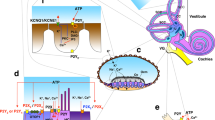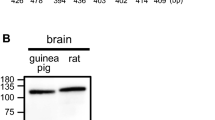Abstract
Membrane-bound ectonucleoside triphosphate diphosphohydrolases (E-NTPDases) in the inner ear regulate complex extracellular purinergic type-2 (P2) receptor signalling pathways through hydrolysis of extracellular nucleoside 5′-triphosphates and diphosphates. This study investigated the distribution of NTPDase5 and NTPDase6, two intracellular members of the E-NTPDase family, and linked this to regulation of P2 receptor signalling in the adult rat cochlea. These extracellular ectonucleotidases preferentially hydrolyse nucleoside 5′-diphosphates such as UDP and GDP. Expression of both enzymes at mRNA and protein level was detected in cochlear tissues and there was in vivo release of soluble NTPDase5 and 6 into cochlear fluids. Strong NTPDase5 immunostaining was found in the spiral ganglion neurones and supporting Deiters’ cells of the organ of Corti, while NTPDase6 was confined to the inner hair cells. Upregulation of NTPDase5 after exposure to loud sound indicates a dynamic role for NTPDase5 in cochlear response to stress, whereas NTPDase6 may have more limited extracellular roles. Noise-induced upregulation of co-localised UDP-preferring P2Y6 receptors in the spiral ganglion neurons further supports the involvement of NTPDase5 in regulation of P2Y receptor signalling. Noise stress also induced P2Y14 (UDP- and UDP-glucose preferring) receptor expression in the root processes of the outer sulcus cells, but this was not associated with localization of the E-NTPDases.






Similar content being viewed by others
References
Housley GD, Bringmann A, Reichenbach A (2009) Purinergic signaling in special senses. Trends Neurosci 32(3):128–141
Vlajkovic SM, Thorne PR, Housley GD et al (1998) Ecto-nucleotidases terminate purinergic signaling in the cochlear endolymphatic compartment. NeuroReport 9(7):1559–1565
Vlajkovic SM, Thorne PR, Housley GD et al (1998) The pharmacology and kinetics of ecto-nucleotidases in the perilymphatic compartment of the guinea-pig cochlea. Hear Res 117(1–2):71–80
Vlajkovic SM, Thorne PR, Sévigny J et al (2002) Distribution of ectonucleoside triphosphate diphosphohydrolases 1 and 2 in rat cochlea. Hear Res 170(1–2):127–138
Vlajkovic SM, Vinayagamoorthy A, Thorne PR et al (2006) Noise-induced up-regulation of NTPDase3 expression in the rat cochlea: implications for auditory transmission and cochlear protection. Brain Res 1104(1):55–63
Muñoz DJ, Kendrick IS, Rassam M et al (2001) Vesicular storage of adenosine triphosphate in the guinea-pig cochlear lateral wall and concentrations of ATP in the endolymph during sound exposure and hypoxia. Acta Otolaryngol 121(1):10–15
Thorne PR, Muñoz DJB, Housley GD (2004) Purinergic modulation of cochlear partition resistance and its effect on the endocochlear potential in the guinea pig. JARO 5(1):58–65
Nikolic P, Housley GD, Thorne PR (2003) Expression of the P2X7 rceptor subunit of the adenosine 5′-triphosphate-gated ion channel in the developing and adult rat cochlea. Audiol Neurootol 8(1):28–37
Wang JC, Raybould NP, Lin L et al (2003) Noise induces up-regulation of P2X2 receptor subunit of ATP-gated ion channels in the rat cochlea. NeuroReport 14(6):817–823
Vlajkovic SM, Housley GD, Muñoz DJB et al (2004) Noise exposure induces up-regulation of ecto-nucleoside triphosphate diphosphohydrolases 1 and 2 in rat cochlea. Neurosci 126(3):763–773
Gale JE, Piazza V, Ciubotaru CD et al (2004) A mechanism for sensing noise damage in the inner ear. Curr Biol 14(6):526–529
Piazza V, Ciubotaru CD, Gale JE et al (2007) Purinergic signalling and intercellular Ca2+ wave propagation in the organ of Corti. Cell Calcium 41(1):77–86
Robson SC, Sévigny J, Zimmermann H (2006) The E-NTPDase family of ectonucleotidases: structure function relationships and pathophysiological significance. Purinergic Signalling 2(2):325–441
Zimmermann H (2001) Ectonucleotidases: some recent developments and a note on nomenclature. Drug Dev Res 52(1–2):44–56
Mulero JJ, Yeung G, Nelke ST et al (1999) CD39-L4 is a secreted human apyrase, specific for the hydrolysis of nucleoside diphosphates. J Biol Chem 274(29):20064–20067
Mulero JJ, Yeung G, Nelken ST et al (2000) Biochemical characterisation of CD39L4. Biochem 39(42):12924–12928
Hicks-Berger CA, Chadwick BP, Frischauf A-M et al (2000) Expression and characterisation of soluble and membrane-bound human nucleoside triphosphate diphosphohydrolase 6 (CD39L2). J Biol Chem 275(44):34041–34045
Braun N, Fengler S, Ebeling C et al (2000) Sequencing, functional expression and characterization of rat NTPDase6; a nucleoside diphosphatase and novel member of the ecto-nucleoside triphosphate diphosphohydrolase family. Biochem J 351(3):639–647
Yeung G, Mulero JJ, McGowan DW et al (2000) CD39L2, a gene encoding a human nucleoside diphosphatase, predominantly expressed in the heart. Biochem 39(42):12916–12923
Ivanenkov VV, Murphy-Piedmonte DM, Kirley TL (2003) Bacterial expression, characterization, and disulfide bond determination of soluble human NTPDase6 (CD39L2) nucleotidase: implications for structure and function. Biochem 42(40):11726–11735
Murphy-Piedmonte DM, Crawford PA, Kirley TL (2005) Bacterial expression, folding, purification and characterization of soluble NTPDase5 (CD39L4) ecto-nucleotidase. Biochim Biophys Acta 1747(2):251–259
Trombetta ES, Helenius A (1999) Glycoprotein reglucosylation and nucleotide sugar utilization in the secretory pathway: identification of a nucleoside diphosphatase in the endoplasmic reticulum. EMBO J 18(12):3282–3292
Paez JG, Recio JA, Rouzaut A et al (2001) Identity between the PCPH proto-oncogene and the CD39L4 (ENTPD5) ectonucleoside triphosphate diphosphohydrolase gene. Int J Oncol 19(6):1249–1254
Blánquez MJ, Regadera J, Mariño J et al (2002) Gradual deregulation and loss of PCPH expression in the progression of human laryngeal neoplasia. Mol Carcinog 35(4):186–195
Regadera J, Blanquez MJ, Gonzalez-Peramato P et al (2006) PCPH expression is an early event in the development of testicular germ cell tumors. Int J Oncol 28(3):595–604
Chadwick BP, Frischauf AM (1998) The CD39-like gene family: identification of three new human members (CD39L2, CD39L3, and CD39L4), their murine homologues, and a member of the gene family from Drosophila melanogaster. Genomics 50(3):357–367
Communi D, Boeynaems JM (1997) Receptors responsive to extracellular pyrimidine nucleotides. Trends Pharmacol Sci 18(3):83–86
Santos TG, Souzab DO, Tascaa CI (2006) GTP uptake into rat brain synaptic vesicles. Brain Res 1070(1):71–76
Solanas M, Escrich E, Rouzaut A et al (2002) Deregulated expression of the PCPH proto-oncogene in rat mammary tumors induced with 7, 12-dimethylbenz[a]anthracene. Mol Carcinog 33(4):219–227
Wink MR, Braganhol E, Tamajusuku ASK et al (2006) Nucleoside triphosphate diphosphohydrolase-2 (NTPDase2/CD39L1) is the dominant ectonucleotidase expressed by rat astrocytes. Neurosci 138(2):421–432
Xiang Z, Burnstock G (2006) Distribution of P2Y6 and P2Y12 receptor: their colocalization with calbindin, calretinin and nitric oxide synthase in the guinea pig enteric nervous system. Histochem Cell Biol 125(4):327–336
Kudirka JC, Panupinthu N, Tesseyman MA et al (2007) P2Y nucleotide receptor signaling through MAPK/ERK is regulated by extracellular matrix: involvement of β3 integrins. J Cell Physiol 213(1):54–64
Amadio S, Montilli C, Picconi B et al (2007) Mapping P2X and P2Y receptor proteins in striatum and substantia nigra: an immunohistological study. Purinergic Signalling 3(4):389–398
Vlajkovic SM, Abi S, Wang CJH, Housley GD, Thorne PR (2007) Differential distribution of adenosine receptors in the rat cochlea. Cell Tissue Res 328(3):461–471
Zhang SY, Robertson D, Yates G et al (1999) Role of L-Type Ca2+ channels in transmitter release from mammalian inner hair cells I. Gross sound-evoked potentials. J Neurophysiol 82(6):3307–3315
Robertson D, Paki B (2002) Role of L-type Ca2+ channels in transmitter release from mammalian inner hair cells. II. Single-neuron activity. J Neurophysiol 87(6):2734–2740
Livak KJ, Schmittgen TD (2001) Analysis of relative gene expression data using real-time quantitative PCR and the 2-∆∆CT method. Methods 25(4):402–408
Blánquez MJ, Arenas MI, Conde I et al (2004) Deregulated expression of the PCPH proto-oncogene in human breast cancers. Int J Oncol 5(4):821–830
Hafidi A (1998) Peripherin-like immunoreactivity in type II spiral ganglion cell body and projections. Brain Res 805:181–190
Recio JA, Zambrano N, Pena L et al (2000) The human PCPH proto-oncogene: cDNA identification, primary structure, chromosomal mapping, and expression in normal and tumor cells. Mol Carcinog 27(3):229–236
Cryns K, Thys S, Van Laer L et al (2003) The WFS1 gene, responsible for low frequency sensorineural hearing loss and Wolfram syndrome, is expressed in a variety of inner ear cells. Histochem Cell Biol 119(3):247–256
Kukulski F, Levesque SA, Lavoie EG et al (2005) Comparative hydrolysis of P2 receptor agonists by NTPDases 1, 2, 3 and 8. Purinergic Signalling 1(2):193–204
Filippov AK, Fernandez-Fernandez JM, Marsh SJ et al (2004) Activation and inhibition of neuronal G protein-gated inwardly rectifying K+ channels by P2Y nucleotide receptors. Mol Pharmacol 66(3):468–477
Lee J, Jung ID, Nam SW et al (2001) Enzymatic activation of autotaxin by divalent cations without EF-hand loop region involvement. Biochem Pharmacol 62(2):219–224
Failer BU, Braun N, Zimmermann H (2002) Cloning, expression, and functional characterization of a Ca2+-dependent endoplasmic reticulum nucleoside diphosphatase. J Biol Chem 277(40):36978–36986
Yegutkin G, Bodin P, Burnstock G (2000) Effect of shear stress on the release of soluble ecto-enzymes ATPase and 5'-nucleotidase along with endogenous ATP from vascular endothelial cells. Br J Pharmacol 129(5):921–926
Hirose K, Discolo CM, Keasler JR et al (2005) Mononuclear phagocytes migrate into the murine cochlea after acoustic trauma. J Comp Neurol 489(2):180–194
Kirkegaard M, Murai N, Risling M et al (2006) Differential gene expression in the rat cochlea after exposure to impulse noise. Neurosci 142(2):425–435
Inoue K, Koizumi S, Tsuda M (2007) The role of nucleotides in the neuron-glia communication responsible for the brain functions. J Neurochem 102(5):1447–1458
Acknowledgements
This study was supported by the Auckland Medical Research Foundation. MOK was also supported by the University of Auckland Doctoral Scholarship.
Author information
Authors and Affiliations
Corresponding author
Rights and permissions
About this article
Cite this article
O’Keeffe, M.G., Thorne, P.R., Housley, G.D. et al. Distribution of NTPDase5 and NTPDase6 and the regulation of P2Y receptor signalling in the rat cochlea. Purinergic Signalling 6, 249–261 (2010). https://doi.org/10.1007/s11302-010-9190-y
Received:
Accepted:
Published:
Issue Date:
DOI: https://doi.org/10.1007/s11302-010-9190-y




